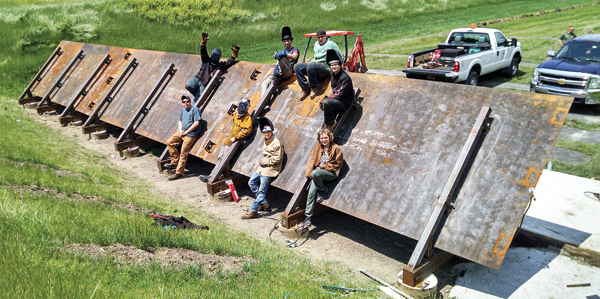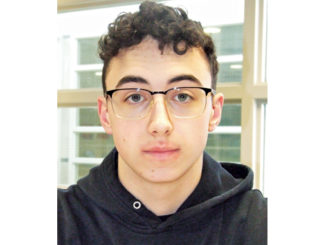
Sebastian Echeverria helped design a county building. He’s not an architect; he’s a senior at Cornwall Central High School. Here’s how he got involved.
PART I: For years the Sheriff’s Department used the shooting range in New Windsor. It was a long drive for the officers, and the range wasn’t always available. So the department created a new range near the Emergency Services Center in Goshen.
The land was available, but the range needed a steel backstop. Rather than bid the job commercially, Ray McDonald of the Sheriff’s Department turned to the Orange/Ulster BOCES Career and Technical Education Center (CTEC), where Sebastian is a student.
“That’s not at all unusual,” CTEC Director Jodie Yankanin says. “Non-profits are always reaching out to us.” Sebastian didn’t get involved at this stage. He’s studying computer-aided design and this was a project for the welding class.
Mr. McDonald met with welding instructor Peter Haskell and described what was needed for the range. It was a one-of-a-kind assignment. Mr. Haskell volunteered his class, but had some silent reservations. “Oh boy,” he said to himself, “what did I say ‘yes’ to?”
Mr. Haskell modified the design so the supports were in the rear, out of the way of the bullets. He made a prototype to see if the design would work, and then involved all the students in his morning and afternoon classes. They worked with six-by-eight-foot steel plates, bolting them together so the connections would be seamless.
It was a win-win scenario. The steel was the only expense for the Sheriff’s Department. The students got to work on an actual job, and Mr. Haskell was happy that he’d agreed to the project. “As a teacher,” he said, “it was an awesome experience.”
PART II: CTEC’s involvement didn’t end with the backstop. The next assignment was designing a training center for the range, which would include a classroom, an office and a conference room.
Sebastian and the other members of the computer-aided design class began work last spring with the help of faculty member Peter Barbour.
They started by interviewing Capt. Anthony Weed, as if he was their client. They asked “How many students in the classroom?” “How many stalls in the bathroom?” “Do you want to have a lobby?”
Once they had the answers, the students researched the codes to see what the requirements would be. Then they sketched each floor of the building. Sebastian said he redid his sketches five or six times.
“It was an opportunity unlike what you’d get in any educational facility,” Mr. Barbour said during a recent interview. All 35 of his students submitted designs. The Sheriff’s Department selected features from three of them, and came up with a composite. The three students were Sebastian Echeverria, Nicole Monda of Monroe-Woodbury and Anthony Pelton of Pine Bush.
PART III: Construction will start soon. Members of the Bruderhof will take the lead, while CTEC students will work on the HVAC, electricity and carpentry.
When the building is finished, it will include a proclamation commending all the students who worked on it.
By the time it’s done, Sebastian will probably be in college in a different part of the state. When we spoke to him on March 14, he said he planned to come back as soon as the building is opened.
SPEAKING OF SEBASTIAN
Sebastian Echeverria contributed to the design of the training center that will be constructed at the Sheriff’s Department’s shooting range.
He’s a Cornwall student, but he attends a computer-aided design course in Goshen for a few mornings every week. It’s an option that’s open to high school juniors and seniors through Orange/Ulster BOCES.
In describing his work on the training center, Sebastian sounded like his instructor. “It was a real hands-on experience that most kids don’t get,” the 12th-grader said. “It was a good resume builder.”
It also enabled him to meet the sheriff and the county executive. Sebastian had studied architecture with Mrs. Eva Whorley at Cornwall Central High School. But working with a client was a new experience for him. “I realized,” he said, “that what I thought wasn’t as important as what the client wanted.”
The assignment started last spring, and stopped (temporarily) during the summer. Or did it? Sebastian continued to speak to the other students who contributed to the building’s design — Nicole Monda of Monroe-Woodbury and Anthony Pelton of Pine Bush. They exchanged emails and text messages almost every day.
That’s probably why Sebastian considers the assignment a team-building experience. He and the other two students all contributed to the final design.
It was interesting, but it won’t be what Sebastian pursues in college. He wants to study computer engineering, while working in a five-year undergraduate program.



